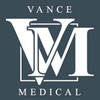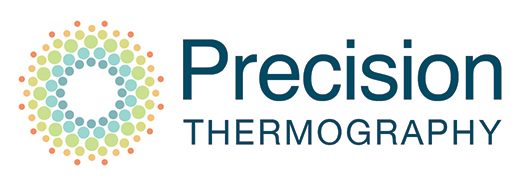“A clever person solves a problem. A wise person avoids it.” – Albert Einstein

What if...
… you could provide breast cancer screening that can potentially detect breast cancer even before it’s large enough to show up on a mammogram?
… the screening involved no pain or radiation?
… the testing could monitor metabolic function in the tissue itself, finding inflammation sooner than other methods?
That technology is here. It's called clinical thermography.
Precision Thermography, A division of Vance Medical, is privileged to provide breast thermography to aid in early breast cancer detection. Computerized infrared imaging can aid you in early detection and potentially prevent breast cancer. This technology is designed to complement physical examination and assist in your breast health plan by using FDA approved, computerized infrared imaging as an adjunctive procedure to help with the diagnosis of breast cancer.
What is Thermography?
Thermography, or infrared imaging, consists of the use of specialized heat sensitive cameras that can detect electromagnetic energy (light) in the infrared wavelengths (heat). As such, these images can serve as a remote sensing system; nothing touches or harms the patient during the evaluation. When the camera’s detectors sense the incoming infrared light, an electrical signal is used to generate a visible image display.
State of the Art Technology
Clinical thermography incorporates the use of high-resolution infrared cameras and sophisticated computer processing to produce a topographic heat map of the visible image of the body. Using the latest technology, computerized thermography produces an accurate and reproducible high-resolution image that can detect even minute changes in skin surface heat emissions. These changes in heat can alert us of a potential underlying problem.
The earliest breast cancer detection is realized when multiple tests are used together (multimodal imaging). With clinical breast thermography, we are promoting a multimodal approach which includes breast self-examinations, physical breast exams by a doctor, thermography, screening imaging, and other studies that may be ordered by your provider.
What is thermography?
Thermography, or infrared imaging, is used in numerous fields such as fabrication, aerospace sciences, construction, military applications, surveillance, astronomy, and of course the medical field. Medical infrared imaging (MIR) uses high-resolution infrared cameras and sophisticated information processing to display a topographic heat map which bears a resemblance to the visible appearance of the body. Modern computerized thermography produces an accurate, high-resolution image that can be analyzed for minute changes in skin surface heat emissions.
MIR is applied in the clinical setting as an aid in the diagnostic process and is used for the thermal analysis of patients with diverse conditions in acute, chronic, and preventative health care.
Is medical Infrared Imaging safe?
Yes! Infrared imaging (or thermography) uses no radiation and does not involve physically touching the body. The procedure is completely safe, painless, and FDA approved, in addition to other tests, as an adjunctive imaging procedure. This imaging does not replace any other form of imaging (e.g. CT, MRI, mammography), but is designed to be used in addition to other tests to provide physical information that cannot be obtained from an exam procedure. The FDA approved thermography as follows: “Telethermographic systems intended for adjunctive diagnostic screening for the detection of breast cancer or other uses” (Code of Federal Regulations – Title 21, Section 884.2980 Telethermographic Systems).
Does thermography replace mammograms?
The answer to this is a resounding no; the two tests complement each other. Thermography should be used in addition to other imaging technologies as part of a woman’s regular breast health protocol. The consensus among health care experts is that no one method of imaging is solely adequate for breast cancer screening. The false negative and positive rates for currently used examination tests (including thermography) are too high for the procedures to be used alone. However, thermography may detect thermal markers that indicate the risk of cancers not detected by other tests. Since it has been determined that 1 in 8 women will get breast cancer, we should use every means possible to detect these tumors when there is the greatest chance for survival. Adding these tests together significantly increases the chance for early detection.
Are there standards under which thermograms need to be taken?
Without guidelines, thermography images would be ineffectual. In order to prevent artifacts on the images, every patient is provided with a list of pre-imaging instructions which are also provided below. The thermography room must be designed properly and environmentally controlled which means a draft-free cool room that is very thermally stable. Prior to the imaging the patient will also need to spend 15 minutes, disrobed from the waist up, acclimating to the room in order to allow the surface temperature of the body to equilibriate with the room. This acclimation is necessary in order to express accurate thermal information. Clothing will also leave marks on the surface of the body (thermal artifacts) and must be removed before imaging can take place.
Pre-imaging instructions:
8 weeks:
You must wait at least 8 weeks after having a lumpectomy or surgical biopsy of the breast before a thermogram can be performed.
4 weeks:
You must wait at least 4 weeks after having a fine needle or core biopsy of the breast before a thermogram can be performed.
5 days:
Abstain from prolonged sun exposure (especially sunburn) to the body areas being imaged 5 days prior to the exam.
24 hours:
A. Abstain from treatment (chiropractic, acupuncture, TENS, physical therapy, electrical muscle stimulation, ultrasound, hot or cold pack use).
B. Abstain from physical stimulation of the breasts for 24 hours before the exam, and if you are nursing please try to nurse as far from 1 hour prior to the exam as possible.
C. Please notify our office If you have had any surgical procedure within 12 weeks prior to coming in for your appointment.
Day of thermography:
A. Abstain from shaving the areas to be imaged the day of the exam.
B. Abstain from any deodorants, lotions, creams, powders, or makeup (no facial makeup for full body or upper body scans).
4 hours:
A. Abstain from exercise 4 hours prior to the exam.
B. Avoid taking Prescription pain medication 4 hours prior to the examination. You must consult with the prescribing physician for his or her consent prior to any change in medication use such as this.
1 hour:
Abstain from taking a bath less than 1 hour before the exam.
Will the Thermologist Provide Me With Treatment Recommendations?
All treatment must be directed by your doctor and not the thermologist. Your physician is the one who understands your history, performed physical exams and reviewed your health markers. All findings and recommendations on the report are for the benefit of your doctor to use in determining any further care necessary. The findings and recommendations on the report are sufficient enough for your doctor to use in providing care. If further action is needed, such as breast ultrasound, MRI or mammogram, your doctor will instruct you as to what measures to take.
Is a Cold Challenge Necessary?
The use of the cold-challenge was stopped in the late 1980’s. This protocol consisted of placing the patient’s hands in ice-water, using ice mitts, or using ice packs placed on the mid-back. The research at the time showed that using the cold-challenge did not increase the sensitivity or specificity of breast thermography. However, despite that finding, some offices have websites telling women that they should never go to any office or imaging center that is not doing the cold-challenge. There is a concern with this that some offices may also insinuate that the breast thermography is not accurate without doing the cold challenge. In 2013, the AAT formed a standards and guidelines committee to review the current status of breast thermography and create an updated internationally peer-reviewed standards and guidelines document. With regard to the cold-challenge, a review of the literature along with a consensus among the experts reaffirmed that the cold-challenge did not improve the sensitivity or specificity of breast thermography; and as such, its use was not necessary to provide accurate infrared imaging of the breast.

